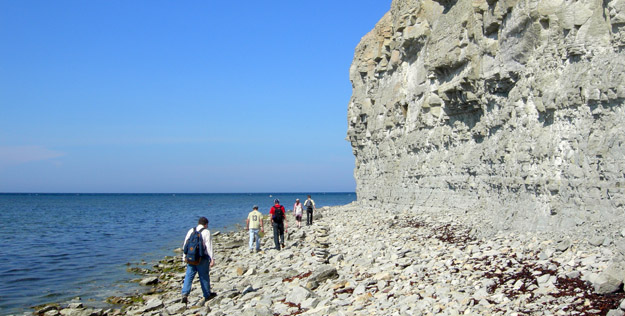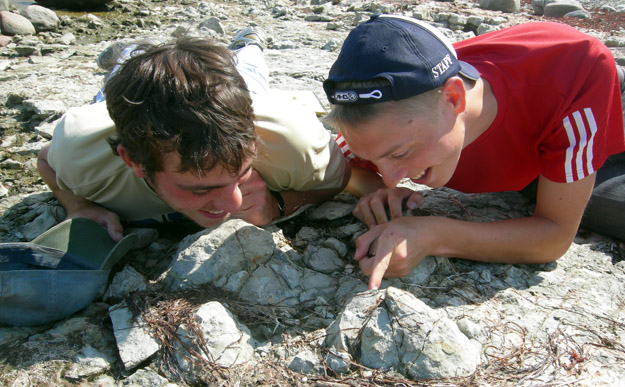
The Estonia team at Panga Cliff on the northern coast of Saaremaa (N58.55321°, E22.28577°). Note the gorgeous weather.
KURESSAARE, SAAREMAA ISLAND, ESTONIA–It was an exquisitely crystalline day of blue and gray here with clear skies, a sparkling sea, and beautiful limestones just waiting for the touch of our hammers. We continued to explore the Lower Silurian (Wenlock) of the Saaremaa coast, fascinated with the numbers and varieties of fossils we found. These rocks have been carefully cataloged by biostratigraphers, so we know exactly how they fit into the larger geological picture in time and space. This gives us the opportunity to concentrate on the paleontological and sedimentological questions before us.
There is a distinctive and widespread horizon in these rocks of stromatoporoids, a kind of calcareous sponge which built on the shallow seafloor stony mounds up to the size of large cabbages. These stromatoporoids were bored by at least two kinds of worm-like organisms, and then encrusted by corals and bryozoans. Some corals even grew inside the skeleton of the sponges in a kind of symbiosis. There are many riddles here about how these fossils are preserved, how the community was structured, and what sort of environment it flourished and was eventually buried in. This will be the basis of Rob McConnell’s Independent Study thesis. We will all return to this site in a few days to do the detailed work of measuring, counting and collecting.

Rob and Palmer closely examine stromatoporoid fossils found in place at the foot of the Liiva Cliff on the northern coast of Saaremaa (N58.57553°, E22.36821°).
Rob, by the way, was reunited with his luggage late this afternoon, so he’s a happy man.



Hello, welcome to Estonia! It was very surprising to find you here in Estonia on this moment. I came to your site via one photograph on wikipedia – a receptaculites from Estonia. Hope you have found a lot of nice fossils this time. You are also very welcome to visit our collections at the university in Tallinn … see for more in our web-site. You can contact me if you like that idea 🙂
Dr. Helje Pärnaste